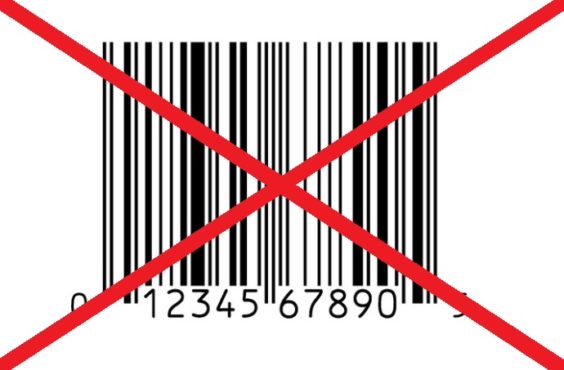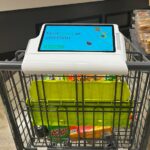Bar codes have existed, largely unchanged, for decades. The most recent improvement, the longer GS1 DataBar, is one that many couponers would argue is not an improvement at all. It merely gave rise to some stores’ maddeningly frustrating coupon policies that state “if it doesn’t scan, we can’t take it.”
So how to improve upon the improvement? How about getting rid of those pesky black-and-white bar codes altogether? That’s exactly what one company is working to do.
The Oregon-based technology company Digimarc is not suggesting we return to the days when cashiers had to manually enter coupons, or check the price tags of products in order to add them up. Instead, it’s aiming to make better bar codes, by making them ubiquitous – and invisible.
Digimarc’s watermarked bar codes can be imprinted all over a product’s packaging, while remaining invisible to the naked eye. So multiple copies of the same bar code can be printed on a product’s top, bottom, front, back and sides, facing up, down, sideways or any which way, so a cashier can scan it without having to pause, look for a bar code, and position it in just the right way so the scanner will read it.
Digimarc demonstrated its system at the National Retail Federation’s Annual Convention and EXPO in New York last week, and set a Guinness World Record in the process. Company representatives scanned and bagged 50 grocery items in 51.91 seconds – shattering the previous record of 75 seconds. “It’s amazing how fast you can scan when you don’t have to hunt for the UPC code,” said Digimarc’s Executive Vice President Ed Knudson.
So could this technology also be applied to coupons? Might cashiers someday be able to scan your entire stack of coupons in record time as well?
Absolutely, Digimarc’s Market Development Manager Matthew Szerencse told Coupons in the News. “Now that Digimarc has moved into the product barcode market it would be a natural transition to use that same technology in the printed coupon market,” he said. “Just like a Digimarc Barcode applied to a product package, it would increase the scanning speed of the printed coupon.”
Digimarc’s invisible bar codes could help you score more coupons, too. They’re also designed to take the place of QR codes, so you can use a smartphone to scan an advertisement in store, or in a magazine, to access product details, recipes or a digital coupon without having to point and position your phone just right.
Digimarc already has a number of print partners that are using its digital watermarks in magazine ads. It’s now seeking to work with brands that are interested in updating their packaging and coupons with the invisible bar codes. Not only would it speed up checkouts, but it could also improve products’ aesthetics – no longer would they have to reserve real estate on their packages for ugly bar codes. That’s even more true with coupons, which are often so small that they’re dominated by their bar codes. Eliminating visible bar codes would free up more space on coupons for product information and images (or more fine print, if the lawyers get their way).
Digimarc says using its technology on coupons would be cost-effective as well. Clients “are charged by the Digimarc instead of circulation,” Szerencse explained. “So theoretically millions of coupons could be issued with the same Digimarc applied, keeping costs low for the provider.”
One other positive (or negative, depending on your perspective) outcome of coupons with Digimarc bar codes, could be the end of coupon bar code “decoding”. Some ethically-challenged couponers have been known to decipher bar codes, in order to determine if higher-value coupons will “work” on other, lower-priced products from the same company. That would be awfully hard to do, if the bar codes are invisible.
But for most of us, a speedier checkout and less drama over coupons that won’t scan, would be well worth it. Especially if it means that “if it doesn’t scan, we can’t take it” will no longer be a policy – or an excuse.















When a cashier tries to scan my groceries and coupons as fast as he can, most of the time there are errors. I personally do not want my groceries and coupons scanned faster. I want to be able to watch as the items and Qs are scanned so that I can be sure I am being charged the correct price and getting credit for all my Qs. Otherwise, it means a trip to Customer Service and standing in another line after checkout. And, if the issue is that I didn’t get credit for all my coupons, the actual coupons have to be retrieved from the cashier where I checked out. Accuracy trumps speed every time!
Hi Lisa,
Thanks for your comment. I think you will be pleasantly surprised with not only how fast packages and coupons can be scanned, but also the accuracy of the results. The data that is in today’s barcode is repeated multiple times over the entire package and coupon with our technology, so the chance of a scanning error is significantly lower.
Matthew, I’m not concerned with the technology. The problem I most often encounter at checkout is when the store has the wrong price encoded in their computer. Another common problem I have is when all of my coupons are not scanned, usually due to the cashier picking up two coupons at once to scan, and the one hidden underneath does not get scanned; or the computer stalls on a coupon because the cashier is instructed to confirm the item has been purchased or that the dollar amount of the coupon is correct. If the cashier is rushing through the coupons, by the time the cashier realizes the computer has stalled, she isn’t sure which coupon caused the problem. At that point she must backtrack to see how many of the coupons didn’t register. Most of us couponers prefer that the cashier take her time when scanning our coupons so that we can be sure that each and every one of them gets scanned accurately. We work hard to save that little bit of money.
The problems mentioned above are caused by human error and I’m not convinced that technology can correct them. In fact, I’m afraid that faster technology will only compound these errors. My concern is our modern society’s obsession with speed vs. accuracy. ( Case in point, look at how many spelling and grammar errors there are online and even in print media these days.)
My understanding from reading this article is that you are trying to sell this new technology to the stores based on how much faster checkout will be. The stores need to take into account how important it is to have human interaction between customers and the store’s employees. In many stores, the only store employee you come in contact with is the cashier. Some of us customers don’t want to feel rushed at checkout.
Don’t get me wrong. I think this technology is a wonderful idea as long as it does not increase prices. I shop at ten to twelve stores each week, and the only times I have experienced a slow-down in the scanning process is when the cashier is attempting to scan a large heavy item, such as dog food, or if the UPC is printed on an area of the product that doesn’t sit flat or tends to get wrinkled.
Sorry to go on so long here, but I thought you might want to know about the concerns and experiences of an average shopper and couponer. (Actually I am over 50 and a touch obsessive compulsive, so maybe I’m not average after all.) 🙂
I highly recommend Lisa as a consultant to any company – she always has a thought-provoking perspective! 😉